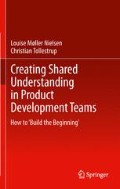Abstract
In the previous chapter the identification and characteristics of the significant models were unfolded and exemplified. This chapter will go a step further in terms of qualifying the significant models definition-wise. A large part of this study has actually evolved around the puzzling question: What are these significant models? Initially, both boundary objects and metaphors seemed to be plausible definitions. However, as it already has been revealed, none of these definitions fully covered the characteristics of the significant models, and it was therefore found necessary to present and identify the significant models as something new and not previously defined. This chapter will start with a review of the comparison between the significant models and boundary objects and metaphors, respectively. This will be done to show why these definitions were disqualified as explanations for the significant models. A naming of the significant models will follow this review. And to underline this, the characteristic elements of the significant models, which have been found in the previous two chapters, will be summarized.
Access this chapter
Tax calculation will be finalised at checkout
Purchases are for personal use only
References
Henderson K (1991) Flexible sketches and inflexible data bases: visual communication, conscription devices, and boundary objects de sign. Eng Sci Technol Hum Values 16(4):448–473
Lakoff G, Johnson M (1980) Metaphors we live. University of Chicago Press, Chicago
Star SL, Griesemer JR (1989) Institutional ecology, ‘translations’ and boundary objects: amateurs and professionals in Berkeley’s Museum of Vertebrate Zoology, 1907–1939. Soc Stud Sci 19:387–420
Author information
Authors and Affiliations
Corresponding author
Rights and permissions
Copyright information
© 2013 Springer-Verlag London
About this chapter
Cite this chapter
Møller Nielsen, L., Tollestrup, C. (2013). Personal and Shared Experiential Concepts. In: Creating Shared Understanding in Product Development Teams. Springer, London. https://doi.org/10.1007/978-1-4471-4180-8_6
Download citation
DOI: https://doi.org/10.1007/978-1-4471-4180-8_6
Published:
Publisher Name: Springer, London
Print ISBN: 978-1-4471-4179-2
Online ISBN: 978-1-4471-4180-8
eBook Packages: EngineeringEngineering (R0)

